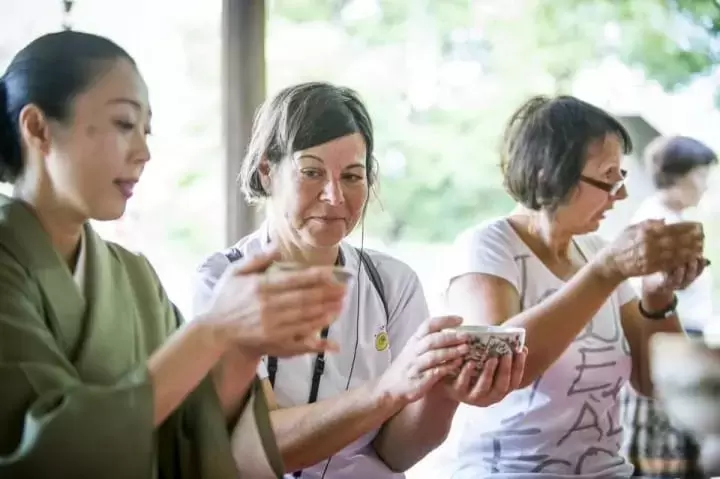Chanoyu (Tea Ceremony) - Japanese Encyclopedia

This article takes a look at the traditional practice of Chanoyu, or the Japanese tea ceremony. From wholeheartedly making tea for your guests to enjoying the ceremony itself, let's take a look at some of the aspects of chanoyu.
Chanoyu (茶の湯) is a word referring to the traditional style of entertaining one's guests with specially prepared matcha, or powdered green tea. Matcha is made from powdered, refined new tea leaves, and is loved for its refreshing, slightly bitter taste.
Koicha (Strong Tea) or Usucha (Light Tea) - Which Do You Prefer?
To be invited to participate in a tea ceremony requires one to behave in a manner that is considered quite formal nowadays. However, casually enjoying yourself while respecting traditional values has been growing in popularity even with the Japanese recently.

Image from Tokyo Grand Tea Ceremony Party 2014 in Hama-rikyu Gardens
If you don't have a tatami room, sitting at the table will do. If you can't sit in seiza style (sitting on the soles of your feet), you can take a seat on a chair or stool. Using the tools that appeal most to you, the concept of the tea ceremony is that, first and foremost you should enjoy the process of making tea yourself before inviting your guests to join in; hospitality is the key. If you are visiting Japan and get the chance, rather than recoiling from the rigid rules of the traditional tea ceremony, please keep that point in mind and feel free to enjoy yourself.

photo by PIXTA
In the ceremony, two forms of green tea are typically available: koicha (濃茶) and usucha (薄茶). Koicha is a concentrated, deep emerald green tea made in small quantities by adding hot water to tea powder and whipping it; several people take turns drinking the koicha from the same cup. On the other hand, usucha is a vivid green tea with plenty of water added to it as it is being blended; everyone is given their own cup of usucha. In both ceremonies, and with a sense of the season in mind, Japanese traditional sweets are served alongside the tea. Doesn't that sound lovely?
Let's Look at Some Real Tea Ceremony Utensils
All across Japan you can find museums and galleries that have collections of tea utensils treasured not only for their age but also for their artistic value.
In Tokyo, for example, they can be found at the Tokyo National Museum, the Nezu Museum, the Gotoh Museum and other places. If you are in Kyoto, the KyotoNational Museum, the Urasenke Chadō Tradition, and the Nomura Art Museum also have great collections. In other areas, please check out the MOA Museum of Art in Shizuoka, the Sunritz Museum of Arts in Nagano, Osaka's Itsuō Museum, and the Fukuoka Art Museum in Fukuoka. Please check the websites to see not only their permanent collections but any new exhibitions or upcoming events at these museums.
Read also: Sadō (The Art of Tea) - Japanese Encyclopedia
This is the official account of MATCHA's editorial department. Our articles feature useful travel information for visitors to Japan, from how-to guides to recommended places to visit.





































![[2026] Top 5 Strawberry Picking Spots in Tokushima, Naruto| Farms and Access Guide for January to May](https://resources.matcha-jp.com/resize/720x2000/2025/03/06-227165.webp)

